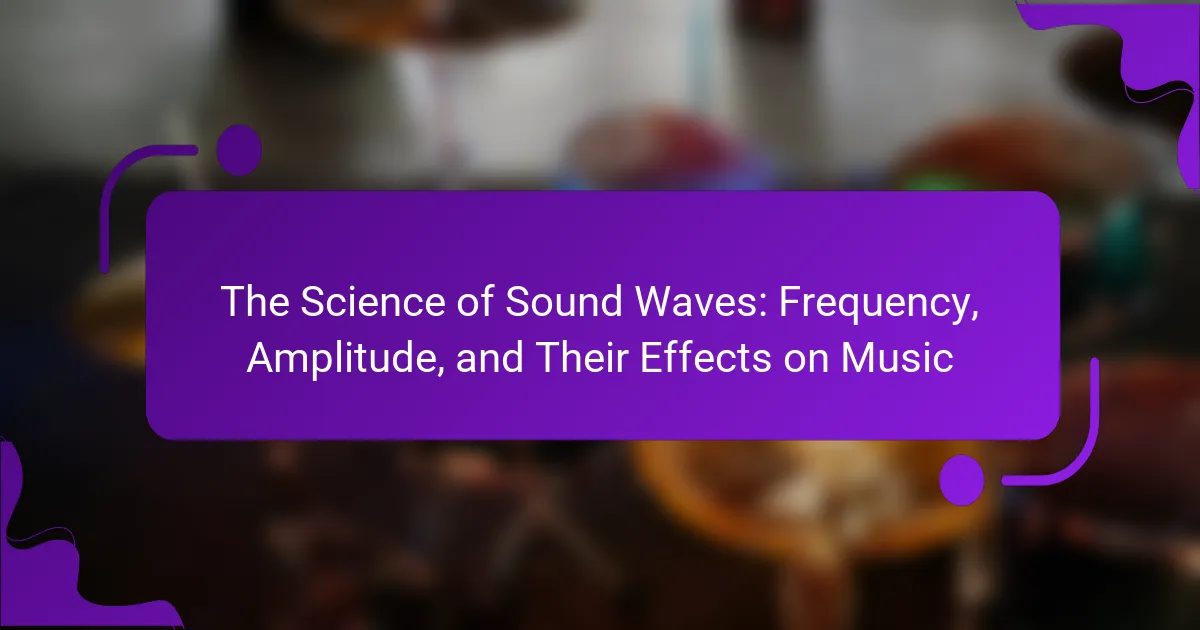The article explores the science of sound waves, focusing on their key characteristics: frequency, amplitude, wavelength, and speed. Sound waves, which are vibrations traveling through mediums like air and water, play a crucial role in music perception. The frequency of sound waves determines pitch, while amplitude affects loudness, both of which significantly influence the emotional response to music. Additionally, the article discusses practical applications of sound wave science in fields such as sound engineering, acoustics design, and music therapy, highlighting how specific frequencies can impact mood and cognitive function.

What are Sound Waves and Their Characteristics?
Sound waves are vibrations that travel through a medium, such as air or water. They are created by the oscillation of particles in the medium. These waves can be characterized by their frequency, amplitude, wavelength, and speed. Frequency refers to the number of cycles per second, measured in Hertz (Hz). Amplitude measures the height of the wave, indicating loudness. Wavelength is the distance between successive crests of the wave. Speed is the rate at which the wave travels through the medium. Sound waves can be classified as longitudinal waves, where particle displacement is parallel to wave direction. Their characteristics affect how sound is perceived in music and other contexts. For example, higher frequency sound waves produce higher pitches, while larger amplitudes produce louder sounds.
How do Frequency and Amplitude Define Sound Waves?
Frequency and amplitude are fundamental characteristics that define sound waves. Frequency refers to the number of cycles a sound wave completes in one second, measured in Hertz (Hz). Higher frequencies produce higher pitches, while lower frequencies result in lower pitches. Amplitude, on the other hand, measures the height of the sound wave, which correlates with loudness. Greater amplitude leads to louder sounds, whereas smaller amplitude results in softer sounds. Together, frequency and amplitude determine the tonal quality and volume of the sound we perceive. For instance, a sound wave with a frequency of 440 Hz corresponds to the musical note A above middle C. A sound wave with an amplitude of 90 decibels is significantly louder than one at 30 decibels.
What is the significance of frequency in sound waves?
Frequency in sound waves determines the pitch of the sound. Higher frequencies produce higher pitches, while lower frequencies result in lower pitches. This relationship is crucial in music and communication. Frequencies are measured in Hertz (Hz), representing cycles per second. For example, a frequency of 440 Hz corresponds to the musical note A4. Human hearing typically ranges from 20 Hz to 20,000 Hz. Understanding frequency helps in sound design and acoustics. It also aids in distinguishing different musical notes and tones. Thus, frequency plays a vital role in how we perceive sound.
How does amplitude influence the perception of sound?
Amplitude directly influences the perception of sound by determining its loudness. Higher amplitude results in louder sounds, while lower amplitude leads to softer sounds. This relationship is quantifiable; for example, an increase in amplitude by 10 decibels corresponds to approximately a doubling of perceived loudness. Human hearing typically ranges from 0 to 120 decibels, with sounds above 85 decibels potentially causing hearing damage. Thus, amplitude plays a crucial role in how we experience and interpret sound intensity.
Why are Sound Waves Important in Music?
Sound waves are crucial in music because they are the medium through which musical sounds are produced and perceived. They travel through air as vibrations, creating the auditory experience of music. Different frequencies of sound waves determine the pitch of notes. Higher frequencies produce higher pitches, while lower frequencies yield lower pitches. Amplitude affects the volume of the sound; greater amplitude results in louder sounds. The interplay of frequency and amplitude shapes the overall texture and dynamics of music. For example, a symphony orchestra utilizes a wide range of sound waves to create rich harmonies and emotional depth. Sound waves also influence the timbre, or quality, of instruments, allowing listeners to distinguish between different sounds. Thus, sound waves are fundamental to the creation, interpretation, and enjoyment of music.
How do sound waves interact with musical instruments?
Sound waves interact with musical instruments by causing vibrations. These vibrations produce sound when the instrument’s material oscillates. For example, in string instruments, sound waves travel along the strings. The tension and length of the strings affect the pitch produced. In wind instruments, air columns vibrate to create sound. The shape and size of the instrument modify the sound quality. Percussion instruments generate sound through striking surfaces, which vibrate upon impact. Each interaction depends on the instrument’s design and materials. This interaction determines the unique timbre of each musical instrument.
What role do sound waves play in music production?
Sound waves are fundamental to music production. They are vibrations that travel through air and other mediums. These waves are characterized by frequency and amplitude. Frequency determines the pitch of the sound. Higher frequencies produce higher pitches, while lower frequencies produce lower pitches. Amplitude affects the loudness of the sound. Greater amplitude results in louder sounds, while smaller amplitude yields softer sounds.
In music production, sound waves are manipulated through various techniques. These include equalization, compression, and reverb. Equalization adjusts the balance of different frequencies. Compression controls the dynamic range of sound waves. Reverb adds depth and space to the audio.
The digital representation of sound waves is crucial in modern music production. Audio interfaces convert analog sound waves into digital signals. This allows for precise editing and mixing. The manipulation of sound waves is essential for creating the desired musical experience.

How Do Sound Waves Affect Music Perception?
Sound waves significantly influence music perception through their frequency and amplitude. Frequency determines pitch, affecting how high or low a note sounds. Amplitude influences loudness, impacting the emotional response to music. Higher frequency sounds are perceived as sharper, while lower frequencies create a sense of depth. Research shows that variations in frequency can alter the listener’s mood and cognitive processing of music. For instance, a study by Levitin et al. (2012) found that frequency changes in melodies can evoke different emotional states. Thus, sound waves shape the overall experience and interpretation of music.
What is the Relationship Between Frequency and Musical Pitch?
Frequency determines musical pitch. Higher frequency results in a higher pitch. Conversely, lower frequency produces a lower pitch. For example, the note A4 has a frequency of 440 Hz. This frequency is commonly used as a tuning standard. The relationship is logarithmic; each octave doubles the frequency. Thus, A5 is 880 Hz, one octave higher. This principle applies across all musical notes. Understanding this relationship is fundamental in music theory and acoustics.
How does frequency affect the notes we hear?
Frequency determines the pitch of the notes we hear. Higher frequencies produce higher pitches, while lower frequencies result in lower pitches. Sound waves vibrate at different rates, measured in Hertz (Hz). For example, a note at 440 Hz corresponds to the musical note A above middle C. The human ear can typically hear frequencies ranging from 20 Hz to 20,000 Hz. Frequencies below this range are considered infrasound, and those above are ultrasound. The relationship between frequency and pitch is fundamental in music theory and acoustics. Thus, frequency directly influences how we perceive musical notes and their distinct sounds.
What is the impact of frequency on musical harmony?
Frequency directly impacts musical harmony by determining the pitch of notes. Higher frequencies produce higher pitches, while lower frequencies yield lower pitches. Harmony arises when different pitches are played together. The relationship between these pitches is defined by their frequency ratios. For example, an octave corresponds to a 2:1 frequency ratio. This ratio creates consonance, which is perceived as pleasant. In contrast, dissonant intervals have more complex frequency ratios, often leading to tension. Therefore, frequency shapes the overall emotional quality of music. Research shows that specific frequency combinations can evoke distinct emotional responses from listeners.
How Does Amplitude Affect Volume and Dynamics in Music?
Amplitude directly affects volume and dynamics in music. Higher amplitude results in louder sounds, while lower amplitude produces softer sounds. Volume is a perceptual response to amplitude levels in sound waves. Dynamics refer to the variations in loudness throughout a piece of music. Changes in amplitude create dynamic contrasts, enhancing musical expression. For example, a crescendo involves increasing amplitude, leading to a more powerful sound. Conversely, a decrescendo decreases amplitude, resulting in a softer passage. Research indicates that perceived loudness increases at a rate of about 10 dB for every doubling of amplitude. This relationship illustrates how amplitude shapes both volume and the overall dynamic range in musical compositions.
What are the ways amplitude influences a musical piece’s energy?
Amplitude directly affects the energy of a musical piece. Higher amplitude produces louder sounds, increasing perceived energy. This loudness can create a more intense emotional response in listeners. Conversely, lower amplitude results in softer sounds, which can evoke calmness or subtlety. The dynamic range, defined by variations in amplitude, contributes to the overall energy flow in a piece. Strong contrasts in amplitude can enhance dramatic moments, engaging listeners more effectively. Research shows that amplitude variations influence listener perception and engagement, highlighting its role in musical expression.
How do dynamics created by amplitude enhance musical expression?
Dynamics created by amplitude enhance musical expression by influencing the loudness and intensity of sound. Changes in amplitude affect how a listener perceives the emotional weight of music. For example, louder passages can convey excitement or aggression, while softer passages can evoke tenderness or introspection. This variation in loudness allows composers and performers to create contrasts and build tension within a piece. Research shows that dynamic range contributes significantly to the emotional impact of music. A study by Juslin and Västfjäll (2008) found that dynamics are crucial for conveying emotions in music. Thus, amplitude dynamics are essential for enriching the listener’s experience and emotional connection to the music.

What Are Practical Applications of Sound Wave Science in Music?
Practical applications of sound wave science in music include sound engineering, acoustics design, and music therapy. Sound engineering utilizes principles of sound waves to enhance audio quality in recording and live performances. Acoustics design applies sound wave science to create optimal listening environments in concert halls and studios. Music therapy employs sound waves to promote healing and emotional well-being. Research shows that specific frequencies can affect mood and cognitive function. For example, binaural beats have been studied for their potential to reduce anxiety and improve focus. These applications demonstrate the integral role of sound wave science in shaping the music experience.
How Can Musicians Utilize Frequency and Amplitude in Their Work?
Musicians can utilize frequency and amplitude to enhance their sound and expressiveness. Frequency determines the pitch of a sound. Higher frequencies create higher pitches, while lower frequencies produce lower pitches. Musicians can manipulate frequency through tuning instruments or using effects like pitch shifting. Amplitude affects the loudness of sound. Higher amplitude results in louder sounds, while lower amplitude produces softer sounds. Musicians control amplitude using dynamics in performance, such as playing softly or loudly. Additionally, mixing techniques can adjust amplitude levels in recordings. Understanding these concepts allows musicians to create desired emotional effects in their music.
What techniques can musicians use to manipulate frequency?
Musicians can manipulate frequency using techniques such as equalization, pitch shifting, and modulation. Equalization adjusts the balance of different frequency components in audio signals. This technique allows musicians to enhance or reduce specific frequencies to shape the overall sound. Pitch shifting changes the perceived pitch of a sound without altering its duration. This can create harmonies or alter the character of an instrument. Modulation involves varying a parameter of a sound wave, such as frequency or amplitude, over time. This can produce effects like vibrato or tremolo, adding depth to the music. These techniques are essential for sound design and music production, allowing for creative expression and refinement of audio.
How can amplitude be adjusted for optimal sound quality?
To adjust amplitude for optimal sound quality, use a sound mixing console or audio software. First, set the initial volume levels for each audio track. Gradually increase the amplitude until the desired loudness is achieved without distortion. Monitor the output level meters to avoid clipping, which occurs when the amplitude exceeds the maximum limit. Use equalization to balance frequencies, as certain frequencies may require different amplitude adjustments. Additionally, consider the acoustics of the environment, as it can affect sound perception. Proper microphone placement can also enhance sound quality by capturing the best amplitude levels. These methods are essential in professional audio production to ensure clarity and richness in sound.
What Tips Can Enhance Understanding of Sound Waves in Music?
To enhance understanding of sound waves in music, start by studying the basic properties of sound waves. Key properties include frequency, amplitude, and waveform. Frequency determines pitch, while amplitude affects loudness. Familiarize yourself with the concept of sound wave propagation through different mediums. Practical experimentation with musical instruments can illustrate these concepts. Listening to various genres can help identify differences in sound wave characteristics. Visual aids, such as waveforms and spectrograms, can provide a clearer representation of sound waves. Resources like textbooks on acoustics and online courses can deepen your knowledge. Engaging in discussions with musicians and sound engineers can also enhance your understanding.
What resources are available for further learning about sound waves?
Books on sound waves include “The Physics of Sound” by Richard E. Berg and David G. Stork. This book covers fundamental concepts in sound physics. Online courses are available on platforms like Coursera and edX. These courses often include lectures and interactive content about sound waves. Educational websites such as Khan Academy offer free resources on sound wave properties. YouTube channels like “Physics Girl” provide engaging videos on sound wave phenomena. Research papers can be found in journals like “The Journal of the Acoustical Society of America.” These papers discuss advanced topics in sound wave research.
How can experimentation with sound waves improve musical skills?
Experimentation with sound waves can enhance musical skills by allowing musicians to understand the properties of sound. This includes frequency, amplitude, and timbre. By manipulating these elements, musicians can develop better pitch recognition and control. Studies show that exposure to different sound wave patterns can improve auditory discrimination. Musicians who experiment with sound waves often report increased creativity and innovation in their compositions. Additionally, using technology to visualize sound waves can help in identifying areas for improvement. Research indicates that active engagement with sound waves leads to greater musical proficiency over time.
The main entity of this article is sound waves, which are vibrations traveling through mediums like air and water. The article explores the characteristics of sound waves, focusing on frequency and amplitude, and their significant roles in music perception, production, and expression. It details how frequency determines pitch and amplitude affects loudness, influencing emotional responses and musical dynamics. Additionally, the article discusses practical applications of sound wave science in music, including sound engineering and music therapy, while providing techniques for musicians to manipulate these attributes for enhanced musical expression.
